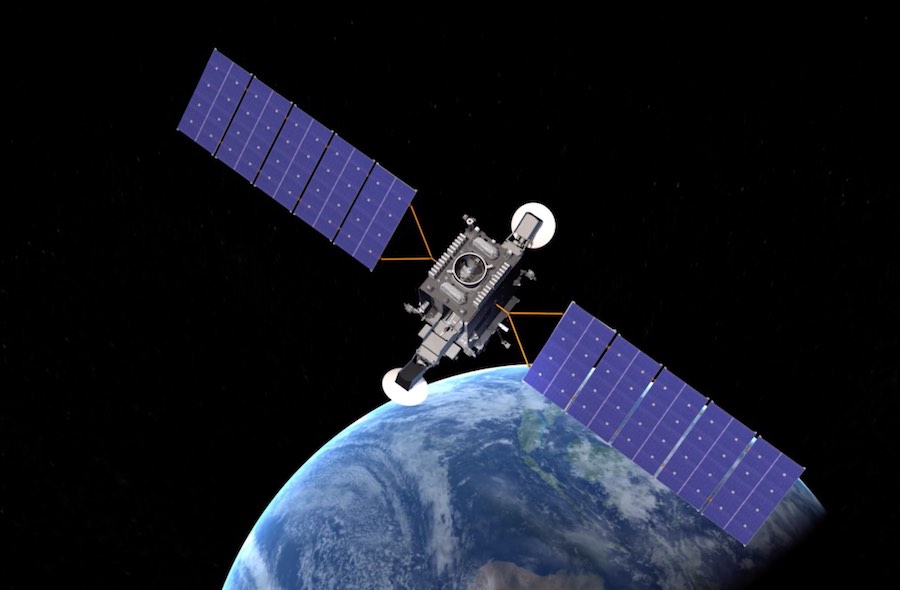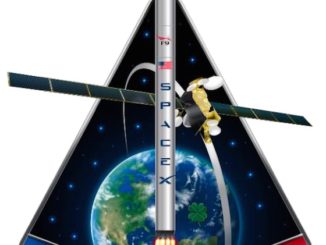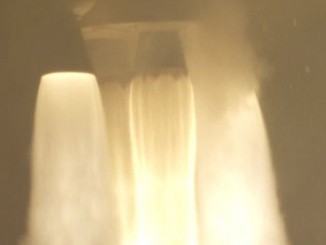EDITOR’S NOTE: Updated March 13 with launch delay to March 26.

The sixth and final satellite in the U.S. Space Force’s network of secure, jam-resistant AEHF communications satellites has been installed on top of a United Launch Alliance Atlas 5 rocket at Cape Canaveral for liftoff March 26.
Built by Lockheed Martin, the spacecraft was encapsulated inside the Atlas 5’s payload shroud — built in Switzerland by RUAG Space — and transported to the Vertical Integration Facility near Cape Canaveral’s Complex 41 launch pad Wednesday.
The AEHF 6 satellite was raised atop the Atlas 5 on its mobile launch platform inside the VIF. Tory Bruno, ULA’s CEO, confirmed Thursday on Twitter that the spacecraft “is resting comfortably atop the ‘Mighty Atlas.'”
The addition of the Advanced Extremely High Frequency payload capped assembly of the 83rd Atlas 5 launcher.
The 197-foot-tall (60-meter) rocket is scheduled for liftoff March 26 during a two-hour window opening at 2:57 p.m. EDT (1857 GMT). Earlier this week, ULA announced a two-day delay in the AEHF 6 launch to March 21 “due to an off-nominal valve reading during launch vehicle processing.”
“Additional time is needed for the team to replace and retest the valve,” ULA said in a statement.
ULA said Friday that the launch would be pushed back again to March 26 after teams needed “additional time to complete the booster valve replacement and retest.”
The Atlas 5 slated to launch the AEHF 6 satellite is flying in the “551” configuration with five strap-on solid rocket boosters and a 5.4-meter (17.7-foot) diameter payload fairing.

The AEHF 6 satellite will be the first major U.S. Space Force payload to launch after the creation of the new military branch in December. It joins five previous AEHF satellites launched on Atlas 5 rockets since 2010, continuing and expanding secure communications services for U.S. military commanders and the president provided by the military’s earlier generation of Milstar spacecraft.
The Space Force is comprised of military units that previously operated under the umbrella of the now-defunct U.S. Air Force Space Command, including space wings that manage launch ranges at Cape Canaveral Air Force Station and Vandenberg Air Force Base in California. The new Space Force military branch remains part of the Department of the Air Force, and also includes the Space and Missile Systems Center at Los Angeles Air Force Base, which oversees launch and spacecraft procurement and development programs, such as AEHF, GPS and SBIRS satellites for communications, navigation and early warning missions.
The AEHF fleet is a follow-on to the Air Force’s Milstar satellite network, and the sixth satellite will be the final craft in the constellation. The AEHF satellites are designed to operate at last 14 years.
Northrop Grumman supplies the communications payloads for the AEHF satellites, each of which provides more capacity than the entire five-satellite Milstar constellation, which launched in the 1990s and 2000s. The AEHF satellites are cross-linked with one another, allowing the network to beam signals around the world without going through a ground station.
The Atlas 5 rocket will deliver the AEHF 6 satellite into an elliptical transfer orbit, then the spacecraft will use its own engine to circularize its orbit more than 22,000 miles (nearly 36,000 kilometers) above the equator.

After reaching a preliminary orbit, the Atlas 5 will deploy a secondary payload named TDO 2 around 31 minutes after liftoff. Based on a suitcase-sized 12U CubeSat platform, TDO 2 carries multiple U.S. government payloads that will provide optical calibration capabilities, which will support space domain awareness, according to the U.S. Space Force’s Space and Missile Systems Center.
“The mission of TDO 2 is to support space domain awareness through optical calibration and satellite laser ranging,” SMC said in a statement. “This capability will assist the nation’s warfighters in performing their critical missions.”
The TDO 2 spacecraft was manufactured by Georgia Institute of Technology and sponsored by Air Force Research Laboratory, according to SMC. It is mounted to the aft end of the Atlas 5’s Centaur upper stage.
A similar secondary payload named TDO 1 accompanied the AEHF 5 satellite into orbit on a previous Atlas 5 launch in August 2019.
Email the author.
Follow Stephen Clark on Twitter: @StephenClark1.



